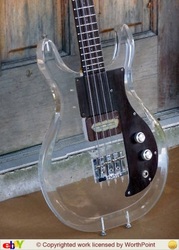D1147A
|
"This is an original Dan Armstrong "see through" bass from either 1969 or 1970. It has a few changed parts but is otherwise original. This bass has some playing wear, but it's in good or better condition and plays and sounds absolutely great! The changed parts on this bass were professionally installed resulting in an excellent setup that minimally impacts the originality of this bass."
"The rock maple neck is straight and the original hardened steel frets are in great shape and also in near perfect condition. The finish on the back of the neck has some playing wear (rubbing of finish) but there are no dings in the wood or detracting surface irregularities. This neck is broken in nicely and feels great. The original tuners (probably Grover guitar machines) were replaced with larger Schaller bass machines. The playing action is amazingly low up the entire neck, and every note above the 12 fret is playable. Intonation is very good too, although a new set of strings always improves intonation." "The original bridge was replaced with a Leo Quan "Badass" bass bridge. The Badass was professionally installed and fits perfectly into the bridge cavity on the body. There were also four tapered grooves etched into the top/body adjacent to the bridge that allow string ball-ends to fit snugly to the tailpiece without scratching the top. In 40 years of guitar collecting, this is the cleanest Badass bridge installation I've seen." "The pickguard appears to be a custom-made wooden veneer guard that conforms to the original plastic faux wood pickguard shape. There is a crack in the pickguard to the right of the bottom-most screw which appears to go through the wood, but it doesn't effect the utility of the pickguard. A guitar cord can be plugged in and out without flexing the pickguard, and it is solid and gig ready. A pickguard screw is missing near the top of the guard, as well as the finger rest." "There's a small white square with numbers visible from behind the bass underneath the neck heel. This is apparently a paper shim that slightly raises the neck tilt. I thought about having it removed, but this bass plays so incredibly well I decided not to mess with it." "The pickup is original, and although the epoxy has chipped away from the magnetic bar, the pickup is strong and has excellent output. In fact, this passive pickup has so much drive, that it sounds like the bass has an active preamp (which it of course doesn't). The two controls are volume and "tone". However there is a twist. Like all stock Dan Armstrong basses, the pickup is actually two stacked coils and they act like independent pickups and the tone control blends between the two coils. The bottom coil is connected to a capacitor that filters out the high frequencies and produces an incredibly deep thunderous sound with absolutely no high tones. The top coil is setup in an opposite manner, and has no deep or bottom tones, so moving the tone pot pans between the two ranges allowing you to dial in just the right sound. And the sound this bass makes is amazing! It's very, very punchy and tight, and can be incredibly deep, or really twangy." "This particular bass is one of the earlier models made from 1969-1970, therefore it doesn't have a toggle switch on the pickguard. The serial number "D1147A" also indicates this is an earlier model (as opposed to a 1971-1972 model). There are small scratches here and there on the body (very hard to show in a picture) but no dings or gouges. Dan Armstrong once told me that this type of plastic is the same as the clear resin used to encapsulate coins, etc (a sixties thing ;-) and that scratches could be rubbed out." "The case is original (made by Ess cases, I believe) and in good condition. The left flip latch is missing, but the center buckle and right flip latch work fine and the case closes firmly. When the case is lying flat, the lid stays up and doesn't sag back. The outside shows some moderate scuffing but is in decent shape. There's an accessory pocket inside with a working hook closure." |



